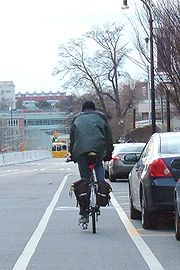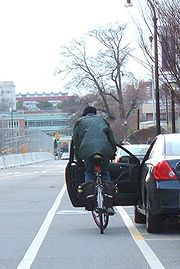
Door zone
Encyclopedia


Parallel parking
thumb|250px|right|Parallel-parked cars in [[Washington, D.C.]]thumb|250px|right|A motorist gets assistance parallel-parkingParallel parking is a method of parking a vehicle in line with other parked cars. Cars parked in parallel are in one line, parallel to the curb, with the front bumper of each...
cars
Automobile
An automobile, autocar, motor car or car is a wheeled motor vehicle used for transporting passengers, which also carries its own engine or motor...
. It is hazardous to ride
Cycling
Cycling, also called bicycling or biking, is the use of bicycles for transport, recreation, or for sport. Persons engaged in cycling are cyclists or bicyclists...
a bicycle or motorcycle in a door zone because if a door is suddenly opened, the cyclist must either crash into it (suffering a dooring), brake suddenly, or swerve into the adjacent lane of traffic. An opening door may also knock the cyclist into passing traffic, leading to serious injuries or death. Despite this hazard, bicycle lanes or cycle lanes are often painted within door zones.
Legal issues
Most areas have laws that require car users to check for bicyclists before opening the door of their vehicle, but there still have been a number of injuries and deaths caused by drivers carelessly opening their doors when a cyclist is passing by without regard for the presence of bicycles, and such laws are very difficult to enforce.Although many areas have laws that apparently require cyclists to ride in bike lanes or near the outside edge of the road, these laws typically have many exceptions, avoiding hazards is usually among them, and compromising safety is implicitly never legally required.
Avoidance
Because it is often not possible to see and react safely to a suddenly opening door, traffic cycling educational programs such as Effective CyclingEffective Cycling
Effective Cycling is a trademarked cycling educational program designed by John Forester, which was the national education program of the League of American Wheelmen for a number of years until Forester withdrew permission for them to use the name...
and CAN-BIKE
CAN-BIKE
CAN-BIKE is a Canadian cycling skills course offered across the country by the Canadian Cycling Association. It is a nationally standardized series of courses on all aspects of cycling safety oriented toward recreational and utilitarian cycling...
teach vehicular cycling
Vehicular cycling
Vehicular cycling is the practice of riding bicycles on roads in a manner that is visible, predictable, and in accordance with the principles for driving in traffic.The phrase vehicular cycling was coined by John Forester in the 1970s to characterize the...
practices which include cycling outside of the door zone. That generally means tracking the bicycle at least five feet away from the edge of parked cars, because the door zone is about four feet and the cyclist typically extends about one foot to each side of where the bike tracks.
When riding in this position invites motorists to squeeze into the lane too close to the cyclist, traffic cycling experts recommend using the full lane to avoid unsafely sharing the lane side by side with other vehicles.
External links
- The "Door Zone" includes instructive diagrams.
- The Door Zone Project

